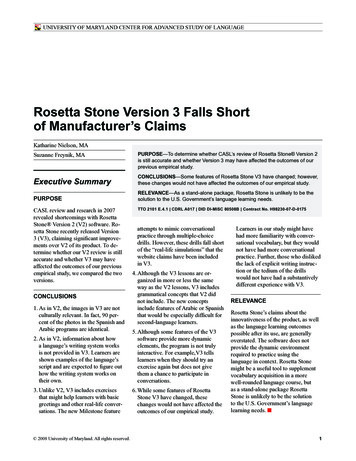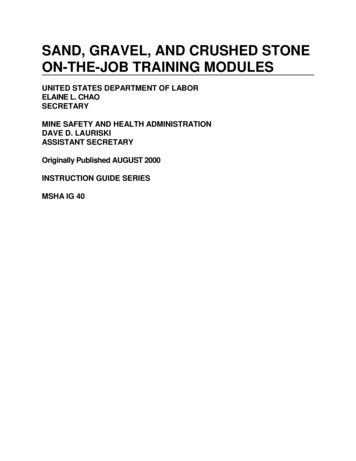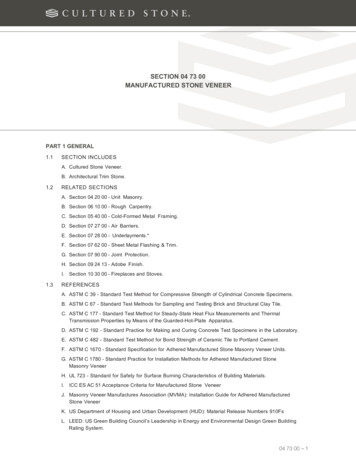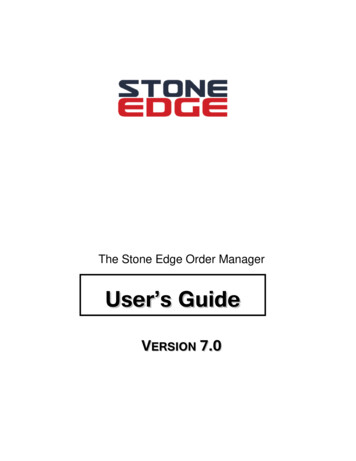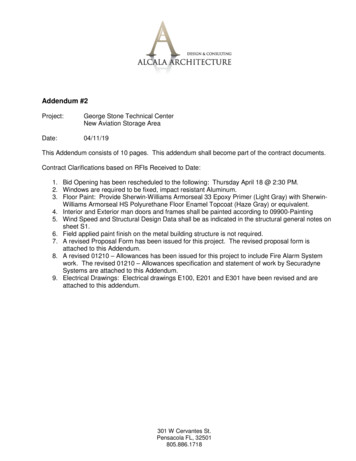
Transcription
The Rosetta Stone of Commercial Operations—Deciphering Where to FocusWinning sales organizations excel at these fiveessential capabilities.By Chris Dent, Greg Callahan and Tom Whiteley
Chris Dent is a principal and Greg Callahan and Thomas Whiteley arepartners with Bain & Company’s Customer Strategy & Marketingpractice. They are based, respectively, in Chicago, Boston and London.Copyright 2019 Bain & Company, Inc. All rights reserved.
The Rosetta Stone of Commercial Operations—Deciphering Where to FocusAt a GlanceAs the selling environment has become more complex, sales leaders are requiring more functionality from their sales operations groups, yet finite budgets mean it’s important to knowwhich investments yield the highest returns.Bain’s data set of 200 companies shows that these new teams with a broader mandate, nowconsidered “commercial operations,” are built around 14 critical capabilities.The fastest-growing companies are four times more likely than laggards, on average, to havebest-in-class performance on five foundational capabilities.Building on those five, leading sales organizations selectively invest in other capabilities thatamplify their strategy, depending on their industry and go-to-market model.In most companies, the sales operations function has failed to keep up with an increasingly complexselling environment. This group has traditionally focused on activities such as forecasting and incentivemanagement, but with the proliferation of digital tools, digital engagement models and multichannelselling motions, sales operations must evolve. That’s why more business-to-business (B2B) companieshave been transforming these operations. The reconfigured “commercial operations” function nowperforms new activities and has a broader, more strategic mandate.In their search to define this new commercial operations function, sales executives often want to tinkerwith organizational design. But, in fact, success is less about where the capabilities reside and moreabout tightly linking the capabilities to the sales and marketing organizations.Bain & Company and Dynata research on 200 B2B companies in the US, combined with our experienceworking with hundreds of sales organizations, find that 14 capabilities underpin the commercial operations group (see Figure 1).Sales operations groups have traditionally covered some of these capabilities, such as the three capabilities in the category of sales and marketing execution. Now, for the first time, commercial operations groups are taking up some of the other capabilities, such as those under the commercial strategyand planning category.While investing in all capabilities might be ideal, sales leaders with finite budgets and tight timeframes rarely have that luxury. They look instead for indicators about where they can get the highestreturn on investment (ROI). Our data analysis, again, reinforced by long experience working withsales organizations, identifies five capabilities that are fundamental table stakes for all B2B companies(see Figure 2):1
The Rosetta Stone of Commercial Operations—Deciphering Where to FocusFigure 1: These 14 capabilities underpin sales and marketing effectivenessCommercial strategy and ategy anddesignCustomerexperienceand loyaltyTerritory andaccount planningIncentives andgoal settingSales financeand budgetingSales and marketing executionSales and marketing insightsPipeline and forecast supportPricing and sales cycle supportTalent and enablementTalent strategy and recruitingSales enablement and trainingData infrastructure, applications and analyticsData infrastructureCore commercial applicationsData science and analyticsSource: Bain & CompanyFigure 2: Successful commercial operations teams excel in five foundational capabilitiesLikelihood that a company executes each capability at a best-in-class levelLowHighMarket opportunity definitionGo-to-market strategy and designCommercialstrategyand planningTerritory and account planningCustomer experience and loyaltyIncentives and goal settingSales finance and budgetingSales andmarketingexecutionTalent andenablementDatainfrastructure,applicationsand analyticsSales and marketing insightsPipeline and forecast supportPricing and sales cycle supportTalent strategy and recruitingSales enablement and trainingCore commercial applicationsData infrastructureData science and analyticsLeadersLaggardsNotes: Leaders (top 15% of companies) are significantly growing market share and revenue; laggards (bottom 15%) have flat or declining market share and revenueSource: Bain/Dynata Sales Operations Survey, September 2018 (N 200)2
The Rosetta Stone of Commercial Operations—Deciphering Where to Focus market opportunity definition; go-to-market strategy and design; incentives and goal setting; pipeline and forecast support; and sales enablement and training.Our analysis finds that leading companies (defined as the top 15% in revenue and market share growth)are 50% more likely than laggards (defined as the bottom 15% in revenue and market share growth),on average, to have best-in-class capabilities. And the fastest-growing companies are four times morelikely than laggards, on average, to have best-in-class performance on these five foundational capabilities. Let’s explore each in turn.The fastest-growing companies are four times more likely than laggardsto have best-in-class performance on five foundational capabilities.Five capabilities form the foundationMarket opportunity definition. Identifying target customers and their relative importance is easy.Digging deeper, though, few companies know the total spending or lifetime value of each customer.They should ask, Do we know the potential of each sales representative’s account portfolio? Is mostof the value concentrated in a few representatives’ portfolios, where customers are not adequatelyserved, or have we spread it out to ensure that each account gets the requisite amount of attention tomaximize value?Leading sales organizations do not leave opportunity definition to chance. They build a commercialoperations group that owns the account and prospect database, composed of internal and externaldata, and keeps it up to date. Their algorithms and heuristics shape the data into an estimate of eachcustomer’s total opportunity. A medical device company might rely on, among other things, proceduraldata, such as how many angiograms each hospital performs, to estimate potential demand and measurecurrent share. An office supplies company could track demand catalysts, such as how many white-collarworkers are employed at each location of a customer.Go-to-market strategy and design. Sales capacity has a tendency to simply take last year’s model andmake slight tweaks at the margin, thereby rusting in place. Leading commercial operations groups,3
The Rosetta Stone of Commercial Operations—Deciphering Where to Focusby contrast, take an active approach to planning optimal coverage. After defining the best opportunities,they determine what type of coverage and capacity has the best chance of reaching target customers—in other words, what mix of channels, direct or indirect salesforces, and sales roles are required.This discipline is especially important when significant changes occur, such as when a new productrequires specialist sales reps, or when a European company expands into China, or when a suppliertaking on more small business customers requires an upgraded e-commerce platform and more insidesales staff.Sales capacity has a tendency to simply take last year’s model andmake slight tweaks at the margin, thereby rusting in place. Leadingcommercial operations groups, by contrast, take an active approach toplanning optimal coverage.The commercial operations group identifies where and when these decisions need to be made, makesrecommendations, and shepherds the executive team on the decisions. In a large, matrixed organization(with product owners, regional owners and global owners), the commercial operations group has thebest position to take an enterprise-wide view and promote consistency.Best-in-class teams often have revenue-planning tools that connect market opportunity data with coverage data and that link to the quota-setting process. This allows for a detailed analysis of where theyshould deploy sales resources. One incumbent software company that enjoys rapid growth uses thisprocess to adjust its go-to-market model each year. As the company grew, it was able to shift the mixof new business reps in order to focus on markets with the biggest opportunities. At the same time, itstaffed more mature markets with additional account managers to maintain the existing customerbase. Over time, the commercial operations team guided the company to further diversify its coveragemodel to support a year-over-year growth rate in excess of 20%.Incentives and goal setting. Top commercial operations groups make sure that compensation planslink to desired sales objectives and behaviors, such as selling a new solution or reaching a new set ofcustomers. If a company has a major goal of acquiring new customers, for example, the compensationplan must be geared toward motivating reps to hunt. Best-in-class organizations standardize compensation plans across similar roles and limit the number of measurements to focus on only the mostimportant objectives.A big area of opportunity is the target-setting process. Many companies do this from the top down,defining their revenue target for the year and then dividing that among reps by adding some percentage4
The Rosetta Stone of Commercial Operations—Deciphering Where to Focusto each rep’s target from the prior year. That tack fails to account for variations in rep tenure, ramp-uptime or opportunities at the territory level. Instead, with its analysis and incentive design, a smartcommercial operations group grounds target setting in reality by reconciling top-down financial targetswith bottom-up estimates of market opportunity.One broadcasting company undertook a detailed opportunity definition exercise and then defined thepotential value of each rep’s portfolio. It decided that reps should go beyond their assigned product ineach account and sell the entire portfolio. But the company would have to change its compensationplan, which emphasized assigned products and discouraged selling multiple products. The new planset up individual targets with an expectation of growth and gave equal incentives to all products,which encouraged reps to sell solutions across the portfolio.Pipeline and forecast support. The foundation for commercial operations involves managing andanalyzing the pipeline review process, but the best groups excel through an industrialized set of processes that are more science than art. That is, they base pipeline probabilities on predictive analytics,not on reps’ estimates.Commercial operations should not only maintain a rhythm of pipelinemeetings and monthly forecast calls but should also serve as an intelligence engine, providing insights to support frontline sales managers.Commercial operations should not only maintain a rhythm of pipeline meetings and monthly forecast calls but should also serve as an intelligence engine, providing insights to support frontline salesmanagers, who do not always have time to assess every deal in the pipeline or play detective in reviewing each account with a rep. In addition, commercial operations helps sales leadership accurately“call the number” during each reporting period.Technology-based advanced analytics and automation now underpin pipeline and forecast support,such as rollups of committed revenue estimates. In addition, analytics-based pipeline scoring applications can independently assess the probability that a deal will close based on modeling the attributesof comparable past deals won or lost. That gives managers solid data with which to direct their repsso that reps do not waste time chasing low-probability deals.Sales enablement and training. Sales enablement and training might sound straightforward, but itcan be tricky to execute well given how expansive the mandate is, ranging from new employee orientation to ongoing training to sales collateral development. Too often, training is product-centric, narrow and infrequent—eight hours crammed into a January offsite and forgotten by March.5
The Rosetta Stone of Commercial Operations—Deciphering Where to FocusTo complicate matters, several teams, including human resources, marketing, product and others,own sales enablement. Many companies thus have disjointed and ineffective training, or they leave itto local leaders, which, in reality, means not having much enablement or training at all.Leading commercial operations groups bring the same analytical rigor to enablement and training asthey do to sales forecasting. They use digital tools, such as Microsoft Workplace Analytics, to track theonline calendars and email traffic of reps, and they highlight what top performers do differently.Those behaviors serve as the basis of targeted training.Further, they use multiple training methods, including microlearning via mobile devices or askingsales reps to submit videos of “elevator pitches,” that are scored by artificial intelligence models. Theybuild a library of sales content, measure the utilization of each asset and develop recommendationengines that push specific content to reps based on the characteristics of the opportunity they arepursuing.Standing out from the crowdIf leading companies excel on these five capabilities, do the other nine even matter? Choosing whichof these nine to make substantial investments in will depend on a company’s starting point—namely,the strategic objectives, go-to-market model and industry dynamics.Choosing which of these nine to make substantial investments in willdepend on a company’s starting point—namely, the strategic objectives,go-to-market model and industry dynamics.For example, a company selling complex products to large groups of decision makers may choose tofocus on developing strong account planning capabilities. One global manufacturer realized that itssales teams did not have a consistent approach to identifying growth opportunities for products andservices at their accounts, which was causing the company to lose share to niche competitors. Toremedy this, the commercial operations team redesigned the account planning process, installing adigital planning tool that integrated with the customer relationship management system and that allowed everyone on an account team to view the plan and provide updates. The team recommended anew cadence for reviewing account plans rather than treating them as an annual exercise. As a resultof these changes, the manufacturer saw double-digit increases in pipeline activity across laggingproduct lines.6
The Rosetta Stone of Commercial Operations—Deciphering Where to FocusQuestions to guide the investmentOur research and experience does not point to commercial operations assuming all capabilities or havinga single leader. The group might own everything, or it could function as the integrator of informationfrom multiple other groups in order to deliver a unified message to the field force and reduce the wastethat occurs at the intersection of different groups. Its design should fit the environment in which it operates.When considering where to invest first, start with a self-assessment to understand the commercialorganization’s strengths and weaknesses as well as which capabilities are critical to the chosen strategy. What is our current state? Are the strategic priorities for the sales organization clear? Have those priorities translated into commercial operations capabilities? Based on spending and timing constraints, which capabilities will deliver the highest ROI?Answering these questions and others specific to the five foundational capabilities allows you to triageby weakness and alignment with the strategy (see Figure 3).Figure 3: How do you stack up on the five foundational etstrategy anddesignIncentivesand goalsettingPipelineand forecastsupportSalesenablementand trainingAre you confidentthat your sales teamfocuses on accountsfrom an objective,data-supportedperspective vs.accounts that just“feel” right?Is your go-to-marketdesign rusted inplace? Have youupdated yourorganization toensure that you havethe right resourcestargeting the rightcustomers?Do your incentivesreinforce your targetselling behaviors?If not, what do theyreinforce?Do your salesmanagersconsistently coachtheir teams andreinforce targetbehaviors? If not,what activities aremanagers doing?Do you know whichbehaviors characterizeyour high-performingsales representatives?Do your managersand frontline staffknow them? Whattraining andenablement haveyou implemented toupgrade theorganization?Source: Bain & Company7
The Rosetta Stone of Commercial Operations—Deciphering Where to FocusTo demonstrate the value of commercial operations to the entire sales organization, a firm with solidrevenue can afford to make limited initial investments in just one or two areas that will generatequick wins. One that’s struggling may not have the luxury of time and probably should move on several fronts right away so that it can uncover root causes of dysfunction and begin to correct them. Ineither case, though, shifting to a commercial operations group with a broader mandate will strengthen the entire sales organization.8
Bold ideas. Bold teams. Extraordinary results.Bain & Company is a global consultancy that helps the world’s most ambitious change makersdefine the future.Across 58 offices in 37 countries, we work alongside our clients as one team with a shared ambition toachieve extraordinary results, outperform the competition and redefine industries. We complement ourtailored, integrated expertise with a vibrant ecosystem of digital innovators to deliver better, faster andmore enduring outcomes. Since our founding in 1973, we have measured our success by the successof our clients. We proudly maintain the highest level of client advocacy in the industry, and our clientshave outperformed the stock market 4-to-1.
For more information, visit www.bain.com
Winning sales organizations excel at these five essential capabilities. By Chris Dent, Greg Callahan and
